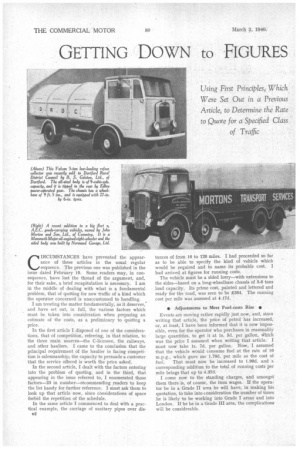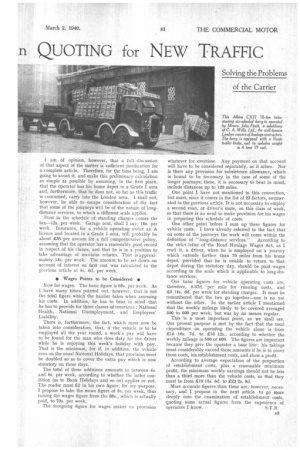GETTING DOWN to FIGURES n QUOTING for NEW TRAFFIC Using
Page 28

Page 29

If you've noticed an error in this article please click here to report it so we can fix it.
First Principles; Which Were Set Out in a Previous Article, to Determine the Rate to Quote for a Specified Class
of Traffic
IRCUMSTANCES have prevented the appear ance of these articles in the usual regular sequence. The previous one was published in the issue dated February 10. Some readers may, in consequence, have lost the thread of the argument, and, for their sake, a brief recapitulation is necessary. I am in the middle of dealing with what is a fundamental problem, that of quoting for new traffic of a kind which the operator concerned is unaccustomed to handling. I am treating the matter fundamentally, as it deserves, and have set out, in full, the various factors which must be taken into consideration when preparing an estimate of the costs, as a preliminary to quoting a price.
In the first article I disposed of one of the considerations, that of competition, referring, in that relation, to the three main sources—the C-licensee, the railways, and other hauliers. I came to the conclusion that the principal requirement of the haulier in facing competition is salesmanship, the capacity to persuade a customer that the service offered is worth the price asked.
In the second article, I dealt with the factors entering into the problem of quoting, and in the third, that appearing in the issue referred to, I enumerated those factors-23 in number—recommending readers to keep the list handy for further reference. I must ask them to look up that article now, since considerations of space forbid the repetition of the schedule.
In the same article I commenced to deal with a practical example, the carriage of sanitary pipes over dis tances of from 16 to 120 miles. I had proceeded so far as to be able to specify the kind of vehicle which would be required and to name its probable cost. I had arrived at figures for running costs.
The vehicle must be a sided lorry—with extensions to the sides—based on a long-wheelbase chassis of 5-6 tons load capacity. Its prime cost, painted and lettered and ready for the road, was seen to be £384. The running cost per mile was assessed at 4.17d.
• Adjustments to Meet Fuel-costs Rise • Events are moving rather rapidly just now, and, since writing that article, the price of petrol has increased, or, at least, I have been informed that it is now impossible, even for the operator who purchases in reasonably large quantities, to get it at 1s. 5d. per gallon, Which was the price I assumed when writing that article. I must now take Is. 7d. per gallon. Now, I assumed that the vehicle would consume fuel at the rate of 10 m.p.g., which gave me 1.70d. per mile as the cost of fuel. That must now be increased to 1.90d. and a corresponding addition to the total of running costs per mile brings that up to 4.37d.
I come now to the standing charges, and amongst them there is, of course, the item wages. If the operator be in a Grade II area he will have, in making his quotation, to take into consideration the number of times he is likely to be working into Grade I areas and into London. If he be in a Grade III area, the complications will be considerable.
I am of opinion, however, that a full discussion of that aspect of the matter is sufficient justification for a complete article. Therefore, for the time being, I am going to avoid it, and make this preliminary calculation as simple as possible by assuming, in the first place, that the operator has his home depot in a Grade I area and, furthermore, that he does not, so far as this traffic is concerned, carry into the London area. I shall not, however, be able to escape consideration of the fact that some of the journeys will be of the nature of longdistance services, to which a different scale applies.
First in the schedule of standing charges comes the tax-12s. per week. Garage rent, shall I say, 10s. per week. Insurance, for a vehicle operating under an A licence and located in a Grade I area, will probably be about £35 per annum for a full comprehensive policy, assuming that the operator has a reasonably good record in respect of his claims, and that he is in a position to take advantage of no-claim rebates. That is approximately 14s. per week. The amount to be set down on account of interest on first cost was calculated in the previous article at 5s. 6d. per week.
• Wage; Points to be Considered •
Now for wages. The basic figure is 68s. per week. As I have many times pointed out, however, that is not the total figure which the haulier takes when assessing his costs. In addition, he has to bear in mind that he has to provide for three classes of insurance : National Health, National Unemployment, and Employers' Liability.
There is, furthermore, the fact, which must now be taken into consideration, that, if the vehicle is to be employed all the year round, a week's pay will have to be found for the man who does duty for the driver while he is enjoying this week's holiday with pay. That is the minimum, for if, in addition, the vehicle runs on the usual National Holidays, that provision must be doubled so as to cover the extra pay which is now statutory on those days.
The total of these additions amounts to between 4s. and 6s. per week, according to whether the latter condition (as to Bank Holidays and so on) applies or not. The reader must fill in his own figure; for my purpose, I propose to take the mean figure of 5s. per week, thus raising the wages figure from the 68s., which is actually
paid, to 73s. per week. • The foregoing figure for wages makes no provision whatever for overtime. Any payment on that account will have to be considered separately, as it arises. Nor is there any provision for subsistence allowance, which is bound to be necessary in the case of some of the longer journeys; these, it is necessary to bear in mind, include distances up to 120 miles.
One point I have not mentioned in this connection, but must, since it comes in the list of 23 factors, enumerated in the previous article. It is not necessary to employ a second man, or driver's mate, on this class of work, so that there is no need to make provision for his wages in preparing this schedule of costs.
One other point before I sum up these figures for vehicle costs. I have already referred to the fact that on some of the journeys the work will come within the
definition of "long-distance services." According to the strict letter of the Road Haulage Wages Act, as I read it, a driver, when he is employed on a journey which extends farther than 70 miles from his home depot, provided that he is unable to return to that depot during the statutory day, should be paid wages according to the scale which is applicable to long-distance services.
Our basic figures for vehicle operating costs are, therefore, 4.37d. per mile for running costs, and £5 14s. 6d. per week for standing charges. It must be remembered that the two go together—one is no use without the other. In the earlier article I mentioned that the weekly mileage likely to be covered averaged 500 to 600 per week, but was by no means regular.
This is a most important point, as we shall see. Our present purpose is met by the fact that the total expenditure on operating the vehicle alone is from £14 16s. 7d. to £16 12s., according to whether the weekly mileage is 500 or 600. The figures are important because they give the operator a base line : his takings must considerably exceed those amounts if he is to cover those costs, his establishment costs, and show a profit.
According to average expectation of the proportion of establishment costs, plus a reasonable minimum profit, the minimum weekly earnings should not be less than a third more than the vehicle costs, so that they must be from £19 15s. 6d. to £22 2s. 8d.
More accurate figures than these are, however, necessary, and I propose in the next article to go more deeply into the examination of establishment costs, quoting some actual figures from the experience of operators I know. S.T.R.




































































